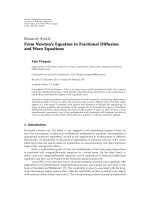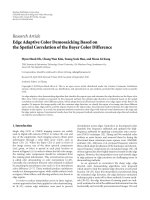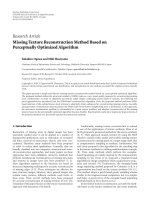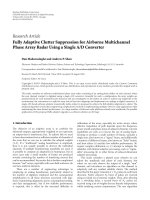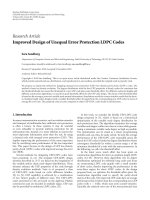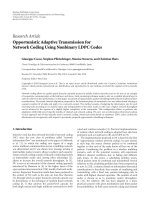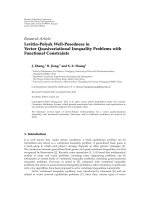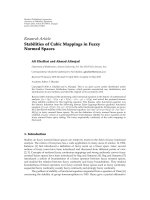Báo cáo sinh học: " Research Article Improved Adaptive LSB Steganography Based on Chaos and Genetic Algorithm" ppt
Bạn đang xem bản rút gọn của tài liệu. Xem và tải ngay bản đầy đủ của tài liệu tại đây (613.34 KB, 6 trang )
Hindawi Publishing Corporation
EURASIP Journal on Advances in Signal Processing
Volume 2010, Article ID 876946, 6 pages
doi:10.1155/2010/876946
Research Article
Improved Adaptive LSB Steganography Based on
Chaos and Genetic Algorithm
Lifang Yu, Yao Zhao, Rongrong Ni (EURASIP Member), and Ting Li
Institute of Information Science, Beijing Jiaotong University, Beijing 100044, China
Correspondence should be addressed to Yao Zhao,
Received 17 November 2009; Accepted 19 May 2010
Academic Editor: Yingzi Du
Copyright © 2010 Lifang Yu et al. This is an open access article distributed under the Creative Commons Attribution License,
which permits unrestricted use, distribution, and reproduction in any medium, provided the original work is properly cited.
We propose a novel steganographic method in JPEG images with high performance. Firstly, we propose improved adaptive LSB
steganography, which can achieve high capacity while preserving the first-order statistics. Secondly, in order to minimize visual
degradation of the stego image, we shuffle bits-order of the message based on chaos whose parameters are selected by the genetic
algorithm. Shuffling message’s bits-order provides us with a new way to improve the performance of steganography. Experimental
results show that our method outperforms classical steganographic methods in image quality, while preserving characteristics of
histogram and providing high capacity.
1. Introduction
Steganography is the science of hiding messages in a medium
called carrier or cover object in such a way that existence of
the message is concealed. The cover object could be a digital
still image, an audio file, or a video file. The hidden message
called payload could be a plain text, an audio file, a video file,
or an image [1, 2].
Steganographic methods can be classified into spatial
domain embedding and frequency domain embedding.Least
Significant Bit (LSB) replacing is the most widely used
steganographic method in spatial domain, which replaces
the cover image’s LSBs with message bits directly. Although
it has several disadvantages such as vulnerable to attacks,
LSB steg anography is a popular method because of its low
computational complexity and high embedding capacity.
In frequency domain, popular steganographic methods
mostly base on Discrete Cosine Transformation (DCT). After
performing DCT on each 8
×8 block and quantizing the DCT
coefficients, message bits are embedded into the quantized
DCT (qDCT) coefficients. Recently, many steganographic
schemes using LSB and its improved versions on qDCT
have been invented, which offer reasonably high embedding
capacity while attempting to preserve the marginal statistics
of the cover image, such as J-Steg [3], F5 [4], and OutGuess
[5]. It is well known that J-Steg is detectable using the χ
2
attack [6, 7] since it is based on simply flipping LSBs. F5
employs matrix encoding to decrease the change for one
payload, but its shrinkage at 0s makes it detectable. OutGuess
embeds message bits into a part of coefficients and uses
the other part to compensate artifacts on the histogram, so
it preserves characteristics of histogram. But its embedding
efficiency and capacity are low because of compensation.
Our contributions are in two folds. First, we present
improved adaptive LSB steganography that can embed mes-
sages adaptively and thus can satisfy various requirements
(high capacity, high security, high image quality, etc.).
Second, our method minimizes degradation of the stego
image through finding the best mapping between the secret
message and the cover image based on chaos and the genetic
algorithm (GA).
The rest of the paper is organized as follows. Section 2
introduces general principles of chaos and GA. Section 3
illustrates our proposed method in detail, which includes
the improved adaptive LSB steganography, a method to
shuffle message bits based on the logistic map and GA,
the embedding procedure and the extraction procedure.
Experimental results are shown in Section 4,wherewe
demonstrate that our method has good stego image qual-
ity, high security-preserving characteristics of histogram,
and high capacity. Finally, conclusions are addressed in
Section 5.
2 EURASIP Journal on Advances in Signal Processing
2. Preliminary
2.1. Chaos and Its Application in Information Hiding. The
chaos phenomenon is a deterministic and analogously
stochastic process appearing in a nonlinear dynamical system
[8, 9]. Because of its extreme sensitivity to initial conditions
and the outspreading of orbits over the entire space, it has
been used in information hiding to increase security [10, 11].
Logistic map is one of the simplest chaotic maps,
described by
x
n+1
= μx
n
(
1
− x
n
)
,(1)
where 0
≤ μ ≤ 4, x
n
∈ (0, 1).
Researches on chaotic dynamical systems show that the
logistic map stands in chaotic state when 3.5699456 <μ
≤ 4.
That is, the sequence
{x
n
, n = 0, 1,2, } generated by
the logistic map is nonperiodic and nonconvergent. All the
sequences generated by the logistic map are very sensitive
to initial conditions, in the sense that two logistic sequences
generated from different initial conditions are uncorrelated
statistically. The logistic map was used to generate a sequence
as the watermark [11] or to encrypt the embedded position
[10, 11] in former works. In our algorithm to be described
below, we use the log istic map to shuffle bits-order of the
message.
2.2. Genetic Algorithm. The genetic algorithm (GA), intro-
duced by Holland [12] in his seminal work, is commonly
used as an adaptive approach that provides a randomized,
parallel, and global search. It bases on the mechanics of nat-
ural selection and genetics to find the exact or approximate
solution for a given optimization problem.
GA is implemented as a computer simulation in which a
population of abstract representations of candidate solutions
to an optimization problem evolves toward better solutions.
The evolution usually starts with some randomly selected
genes as the first generation. All genes in a generation
form a population. Each individual in the population is
called chromosome, which corresponds to a solution in the
optimization problem domain. An objective, called fitness
function, is used to evaluate the quality of each chromosome.
A new generation is recombined to find the best solution
by using three operators: selection, crossover,andmutation
[13]. The process is repeated until a predefined condition is
satisfied.
Once we have the genetic representation and the fitness
function defined, pseudocode algorithm of GA is illustrated
as follows.
(1) Generate initial population.
(2) Evaluate the fitness of each individual in the popula-
tion.
(3) Select best-ranking individuals to reproduce.
(4) Breed a new generation through crossover and muta-
tion (genetic operations) and give birth to offspring.
(5) Evaluate the individual fitness of the offspring.
(6) Replace the worst ranked part of p opulation with
offspring.
c
0
c
1
c
62
c
63
··· ···
c
loc+1
c
loc
Embed l
1
bits to
each valid
coefficient
Embed l
2
bits to
each valid
coefficient
Figure 1: Division of 64 coefficients in a 8 × 8block.
(7) Repeat (3) to (6) until termination condition is satis-
fied.
3. Our Proposed Method
3.1. Improved Adaptive LSB (IA-LSB) Steganography. The
classical LSB steganography replaces cover images’ LSBs with
messages’ bits directly. This embedding strategy leads to
dissymmetry. When the LSB of a coefficient in the cover
image equals to its corresponding message bit, no change is
made. Otherwise, this coefficient is changed from 2n to 2n+1
or from 2n +1to2n—changes from 2n to 2n
− 1orfrom
2n +1to2n + 2 never happen. This dissymmetry is utilized
by steganalysis, known as χ
2
attack [6, 7].
In order to avoid dissymmetry, improved adaptive LSB
(IA-LSB) steganography is proposed. First, the number of
bits to be embedded in a certain coefficient is adaptive. With
proper parameters, we can get high capacity while preserving
high security. Second, less modification rule (LMR) is used to
minimize modification.
3.1.1. Adaptively Decide Bits to be Embedded in Each Coef-
ficient. Let C
=c
0
, c
1
, , c
63
denote the sequence of
quantized DCT coefficients in a certain 8
× 8JPEGblock
of the cover image. loc divides 64 coefficients into two
parts. In the first part, l
1
bits are embedded into each valid
coefficient, and in the second part, l
2
bits are embedded
(shown in Figure 1). We can adjust l
1
, l
2
, and loc to get high
performance according to the content of the cover image.
3.1.2. Less Modification Rule (LMR). Suppose c
i
is assigned to
hold l (l
∈{l
1
, l
2
}) bits. Denote c
i
’s corresponding l message
bits as m
i
(m
i
∈{0, 1, ,2
l
− 1}) decimally, and denote its
corresponding coefficient in the stego image as s
i
.LetLSB
l
(x)
be the decimal expression of the least significant l bits of x.
That is, LSB
l
(x) = x mod 2
l
.
Let s
i
= c
i
+m
i
−LSB
l
(c
i
), s
i
= c
i
−(2
l
−(m
i
−LSB
l
(c
i
))) be
two candidates for s
i
. Because LSB
l
(s
i
) = LSB
l
(s
i
), s
i
and s
i
hold the same message bits. In classical LSB steganography,
s
i
= s
i
. In our method, s
i
or s
i
is chosen according to less
modification rule formulated as follows:
s
i
=
⎧
⎪
⎪
⎪
⎪
⎨
⎪
⎪
⎪
⎪
⎩
s
i
if
s
i
− c
i
<
s
i
− c
i
,
s
i
if
s
i
− c
i
>
s
i
− c
i
,
s
i
or s
i
,randomly, if
s
i
− c
i
=
s
i
− c
i
.
(2)
In this rule, we always choose the change that introduces
less modification. For example, if l
= 2, m
i
= 3, and c
i
= 8,
EURASIP Journal on Advances in Signal Processing 3
Table 1: PSNR of gray images embedded by IA-LSB with and without shuffling message bits, simply denoted as “with” and “without”.
PSNR (db)
Average embedding capacity (bpc)
0.46 0.624 0.731
with without with without with without
Lena 39.93 39.72 38.521 38.181 37.376 37.221
Baboon 33.59 33.41 33.058 32.821 32.381 32.23
Milkdrop 44.32 44.21 40.187 39.92 39.274 38.934
Plane 38.73 38.44 37.586 37.281 36.727 36.506
Start
Initialization
(x
0
, µ)
1
(x
0
, µ)
2
···
···
···
(x
0
, µ)
L
p
Logistic map
Shuffle
GA operators
No. of generations > maxGen?
End
Next generation of (x
0
, µ)
1
(x
0
, µ)
2
···(x
0
, µ)
L
p
Shuffled
message
bits 1
Shuffled
message
bits 2
Shuffled
message
bits L
p
Fitness 1 Fitness 2
Fitness L
p
N
Y
Best solution
(x
0
, µ)
Message
Figure 2: Process of using GA to find the best pair input for logistic
map.
then LSB
l
(c
i
) = 0, s
i
= c
i
+3 = 11, s
i
= c
i
−1 = 7. LSB
l
(s
i
) =
LSB
l
(s
i
), but the absolute value of change from c
i
to s
i
is 3
while to s
i
is 1, so choose s
i
as s
i
. Take another example,
l
= 2, m
i
= 3andc
i
= 10, then L SB
l
(c
i
) = 2, s
i
= c
i
+1= 11,
s
i
= c
i
− 3 = 7. In this c ase, choose s
i
,whichisclosertoc
i
,
as s
i
.
Table 2: PSNR of color images embedded by IA-LSB at 0.45 bpc.
PSNR (db) with without
Lena 35.134 35.011
Baboon 28.62 28.556
Milkdrop 39.384 39.252
Plane 34.518 34.391
3.2. Shuffle Message Bits Based on Chaos and Genetic Algo-
rithm. Shuffling message bits changes the way of modifying
the cover image during embedding thus influences image
quality and security of the stego image. By finding a proper
way to shuffle, we can improve the image quality or security
or both. In this paper, we use the logistic map for shuffling
and use GA to find proper parameters for the logistic map.
Denote the message with length L as M
={m
0
, m
1
,
, m
L−1
}. The process of using the logistic map to shuffle
is stated as follows.
(1) Given a pair of input (x
0
, μ), the logistic map will
generate a sequence
{x
n
, n = 0, 1, 2, }.Wipeoff the
first k (e.g. 1000) elements of the sequence, and use
the consecutive L different elements to form a vector
Y
={y
0
, y
1
, , y
L−1
}={x
k
, x
k+1
, , x
k+L−1
}.
(2) Sort the elements of Y in descending order. The
suffixes of the sorted elements form a s equence I
=
{
i
0
, i
1
, , i
L−1
}.
(3) Shuffle message bits according to I. That is, the
message bit with suffix i
r
in M is put to position r.
Here comes an example of using the logistic map to
shuffle message bits. Let M
={0, 1, 1, 1, 0, 1}, Y ={0.1,
0.6, 0.4, 0.2, 0.8, 0.7
}, then I ={4, 5, 1, 2, 3, 0}, and shuffled
message sequence is
{0, 1, 1, 1, 1, 0}.
From the shuffling process mentioned above, we can
see that the pair of parameters (x
0
, μ) decides the order of
shuffled message bits. In order to improve the performance
of the shuffling method, GA is used to select a proper pair of
(x
0
, μ). In our scheme, we choose to improve quality of the
stego image in the sense of P SNR and select PSNR as GA’s
fitness function:
fitness
= PSNR =−10 · log
10
⎧
⎨
⎩
1
255
2
MN
M
m=1
N
n=1
[d(m, n)]
2
⎫
⎬
⎭
,
(3)
where M and N arenumberofrowsandcolumnsofthe
cover image, respectively; d(m, n) is the difference between
4 EURASIP Journal on Advances in Signal Processing
Message
bits
Cover
JPEG file
Entropy
decoding
Best (x
0
, µ)
selected by
GA
Quantized DCT
coefficients
Logistic map
Shuffled
message bits
IA-LSB
Entropy
encoding
Stego
JPEG file
Figure 3: Embedding procedure of our proposed method.
Stego
JPEG file
Entropy
decoding
Stego quantized
DCT coefficients
Shuffled
message bits
Message
bits
Logistic map
Extracting LSB
m
of coefficient
(x
0
, µ)
Figure 4: Extracting procedure of our proposed method.
0.45 0.50.55
0.6
0.65 0.7
33
34
35
36
37
38
39
40
41
Embedding rate (bpc)
PSNR (db)
Our
F5
MB1
Figure 5: PSNR of our method, F5, and MB1.
coefficients in spatial domain at position (m, n) in the cover
image and in the stego image. The process of using GA to
maximize PSNR is shown in Figure 2 and stated as follows.
(1) Initialize population. Randomly generate L
p
pairs of
(x
0
, μ), x
0
∈ (0, 1), μ ∈ (3.5699456, 4]. L
p
is the size
of population and each (x
0
, μ) is an individual.
(2) For each (x
0
, μ), shuffle message bits and embed the
reordered message bits into the cover image using
IA-LSB steganography, then compute PSNR between
the cover image and the stego image, which is the
fitness function of GA. In the following operations,
the individual with larger fitness function will be
considered better.
(3) GA operators—selection, crossover, and mutation—
are operated to generate the next generation.
−40 −30 −20 −10 0 10 20 30 40
0
0.05
0.15
0.25
0.35
0.1
0.2
0.3
Values of coefficients
Frequency of currence
(2, 1)
Our method
Original
Figure 6: Distribution of the (2,1)th AC components.
(4) Repeat (2) and (3) till the number of generations
equals maximum generation maxGen (e.g., 100).
(5) Put out the best pair of (x
0
, μ) selected by GA.
3.3. Embedding Procedure. Acoefficient c
i
is valid,ifc
i
/
= 0
anditisnotaDCcoefficient. The whole embedding
procedure is depicted in Figure 3. Firstly, the message
bits are shuffled by the logistic map whose input pair
(x
0
, μ) is selected by GA. Secondly, the cover JPEG file is
decoded, obtaining quantized DCT coefficients. Thirdly, the
shuffled message bits are embedded into the valid quantized
DCT coefficients using IA-LSB steganography. Finally, stego
quantized DCT coefficients are encoded to the stego JPEG
file.
It needs to be taken into consideration that valid coef-
ficients after embedding should still be valid, that is, valid
EURASIP Journal on Advances in Signal Processing 5
coefficients should not be changed to 0. On one hand, char-
acteristics of histogram can be preserved; on the other hand,
message bits can b e extracted correctly and simply. If s
i
= 0,
s
i
= s
i
± 2
l
.Toaddorsubtract2
l
is determined randomly.
3.4. Extracting Procedure. After receiving the stego JPEG file
and (x
0
, μ), we can extract the message bits as showed
in Figure 4. First, the stego JPEG file is entropy decoded
to obtain stego quantized DCT coefficients. Second, the
shuffled message bits are extracted from LSBs of valid
coefficients. Thirdly, the shuffled message bits are reordered
to there natural order using logistic map with (x
0
, μ) as input.
Message bits are obtained.
4. Experiments
In this section, we demonstrate the performance of our
proposed method and compare it with that of F5 [14],
MB1 [15], and Outguess [16]. The image quality of each
steganography method is expressed objectively in PSNR.
Standard 256 gray-level and true color images with sizes
of 256
× 256 are used as covers, such as Lena, Baboon,
and Couple. The JPEG quality factor is set to 80 dur ing
compression in each method.
4.1. Image Quality. In order to demonstrate validity of shuf-
fling message bits, we compare the PSNR of images embed-
ded by IA-LSB steganography with and without shuffling
message bits. The results of g ray images are shown in
Table 1.Shuffling message bits does improve the PSNR of the
stego image. It can also be applied to other steganographic
algorithms and provides us with a new way to improve
performance of steganography. Moreover, Table 2 shows that
this scheme of shuffling is not only applicable to gray images
but also color images.
Figure 5 shows the PSNR of our method, F5, and MB1.
The results are averaged on 50 gray-level images. We can
see that the PSNR of our proposed method is hig her than
that of F5 and MB1. For the capacity of Outguess is around
0.3 bpc, it is not shown in the figure. The PSNR of Outguess
is not higher than 32.86 db at 0.3 bpc (bit per nonzero AC
coefficient) but of our method is higher than 37 db even at
0.72 bpc. We can conclude that our method outperforms F5,
MB1, and Outguess in image quality.
4.2. Preserving Characteristics of Histogram. As a represen-
tative example, Figure 6 plots distribution of the (2,1)th
quantized AC components for cover image “Lena” and
its corresponding stego image with an embedding rate of
0.46 bpc. The red line illustrates the coefficients distribution
of a stego image with our proposed method, and green bars
illustrate that of the cover image. Figure 6 shows that our
method preserves the characteristics of histogram. This is
also true for the other components (e.g., (1,2)th, (2,2)th AC
components) and the other testing images.
5. Conclusion
A steganographic method uses IA-LSB based on chaos
and genetic algorithm is proposed. After finding the best
parameters for the logistic map using GA, rearrange the
secret message and embed it into the cover image using IA-
LSB. Experimental results demonstrate that our algorithm
achieves high embedding capacity while preserving good
image quality and high security.
The important and distinctive features in the proposed
method are to minimize the degradation of stego image
by shuffling the secret message based on the logistic map
and GA. To find better mapping between the secret message
and the cover image so as to improve the steganographic
performance is our future work.
Acknowledgments
This work was supported in part by National Natural Science
Foundation of China (no. 60776794, no. 90604032, and no.
60702013), 973 program (no. 2006CB303104), 863 program
(no. 2007AA01Z175), B eijing NSF (no. 4073038), and Spe-
cialized Research Foundation of BJTU (no. 2006XM008 and
no. 2005SZ005).
References
[1] J. Silman, “Steganography and steganalysis: an overview,”
Tech. Rep., SANS Institute, 2001.
[2] T. Jamil, “Steganography: the art of hiding information in
plain sight,” IEEE Potentials, vol. 18, no. 1, pp. 10–12, 1999.
[3] D. Upham, 1997, />∼paul/crypto/jsteg/.
[4] A. Westfeld, “F5-a steganographic algorithm,” in Proceedings
of the 4th International Workshop on Information Hiding,pp.
289–302, Pittsburgh, Pa, USA, 2001.
[5] N. Provos, “Defending against statistical steganalysis,” in
Proceedings of the 10th USENIX Security Symposium, pp. 323–
335, Washington, DC, USA, 2001.
[6] A. Westfeld and A. Pfitzmann, “Attacks on steganographic
systems,” in Proceedings of the 3rd International Workshop on
Information Hiding, 2000.
[7] N. Provos and P. Honeyman, “Detecting steganographic
content on the internet,” Tech. Rep., Center for Information
Technology Integration, University of Michigan, 2001.
[8] Z. Liu and L. Xi, “Image information hiding encryption using
chaotic sequence,” in Proceedings of the 11th International
Conference on Knowledge-Based Intelligent Information and
Engineering Systems and the XVII Italian Workshop on Neural
Networks, pp. 202–208, 2007.
[9] Y. Zhang, F. Zuo, Z. Zhai, and C. Xiaobin, “A new image
encr yption algorithm based on multiple chaos system,” in
Proceedings of the International Symposium on Electronic
Commerce and Security (ISECS ’08), pp. 347–350, August 2008.
[10] R. Munir, B. Riyanto, S. Sutikno, and W. P. Agung, “Secure
spread spectrum watermarking algorithm based on chaotic
map for still images,” in Proceedings of the International
Conference on Electrical Engineering and Informatics, 2007.
[11] Z. Dawei, C. Guanrong, and L. Wenbo, “A chaos-based robust
wavelet-domain watermarking algorithm,” Chaos, Solitons and
Fractals, vol. 22, no. 1, pp. 47–54, 2004.
6 EURASIP Journal on Advances in Signal Processing
[12] J. H. Holland, Adaptation in Natural and Artificial Systems,
MIT Press, Cambridge, Mass, USA, 1992.
[13] Y T. Wu and F. Y. Shih, “Genetic algorithm based methodol-
ogy for breaking the steganalytic systems,” IEEE Transactions
on Systems, Man, and Cybernetics B, vol. 36, no. 1, pp. 24–31,
2006.
[14] />∼westfeld/publikationen/f5r11.zip.
[15] />[16] />
